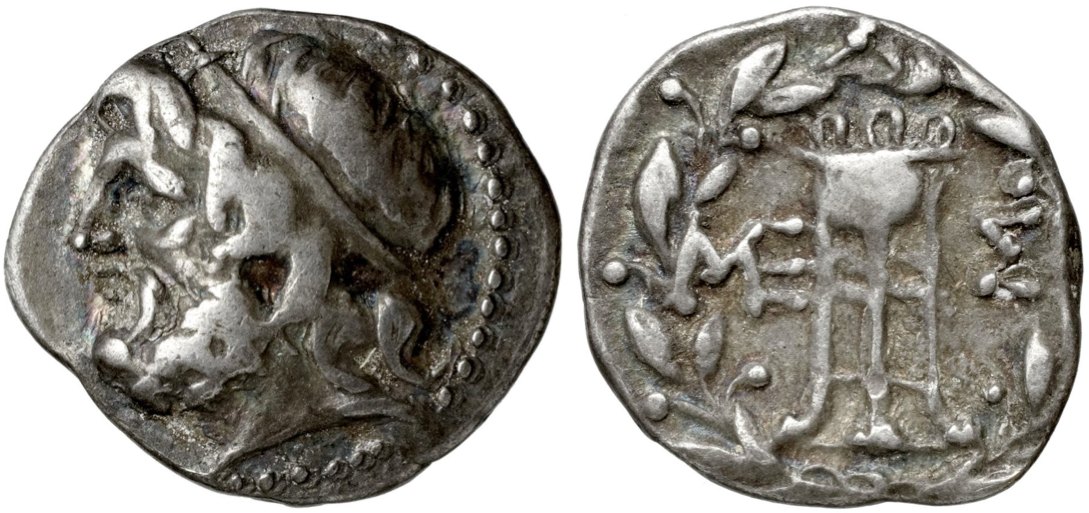RQEM ad. 443 - Messene (Achaean League), silver, triobols or hemidrachms (150-40 BCE)
From SILVER
150 BCE - 40 BCE Silver 5,394 kg
Description
| ObverseInscription or printing placed on the obverse.: | Several types: 1) Head of Zeus left or right, wearing laurel wreath. (In field, globule). Border of dots (issues α-λ), 2) Head of Artemis (?) right, wearing stephane. Border of dots (issue μ). |
| ReverseInscription or printing placed on the reverse.: | MEΣ (Greek).Several types: 1) Laurel wreath (issue α), 2) Tripod with laurel wreath (or olive wreath or ring). In the field or in exergue, letters or name (issues β-μ). |
Mint and issuing power
| MintIdentifies the place of manufacture or issue of a numismatic object.: | Messene | Ancient regionAncient region.: | Peloponnesus | Modern countryModern country: Greece | AuthorityIdentifies the issuing power. The authority can be "pretended" when the name or the portrait of X is on the coin but he/she was not the issuing power. It can also be "uncertain" when there is no mention of X on the coin but he/she was the issuing power according to the historical sources: | Achaean League |
Chronology
| FromIdentifies the initial date in a range assigned in a numismatic context. | 150 BCE | toIdentifies the final date in a range assigned in a numismatic context.. | 40 BCE | PeriodTime period of the numismatic object.: Hellenistic 323-30 BC |
Physical description
| MetalThe physical material (usually metal) from which an object is made.: | Silver |
Median weightMedian of the weights of numismatic objects (in grams). in grams | 2.30 | DenominationTerm indicating the value of a numismatic object. Examples: tetradrachm, chalkous, denarius.: | triobol |
StandardStandard.: |
Image

RQEM_ad_443.png "Paris, BnF, 1966.453.2247 (https" has not been listed as valid URI scheme.[Paris, BnF, 1966.453.2247 (https://gallica.bnf.fr/ark:/12148/btv1b8501190c)]
References
| Die study referencePublication of the study: | Grandjean 20031Grandjean 2003, series X | ||
| Coin series referenceReference to coin series study: | |||
Obverse dies distribution
| FrequencyFrequency of specimen in distribution. ᵖ | Number of obversesNumber of obverse dies. ᵖ (o) | % (o) | Number of coinsNumber of coins. (n) | % (n) | Die nameName(s) of the die(s). |
| 1 | 42 | 52.5 | 42 | 22.83 | 65, 66, 68, 69, 70, 71, 72, 81, 82, 83, 85, 86, 87, 88, 90, 93, 95, 96, 97, 99, 100, 101, 102, 104, 105, 106, 107, 111, 113, 116, 117, 118, 121, 122, 123, 128, 130, 131, 133, 134, 135, 136 |
| 2 | 18 | 22.5 | 36 | 19.57 | 58, 63, 67, 80, 84, 89, 92, 94, 98, 103, 110, 114, 115, 119, 120, 124, 129, 132 |
| 3 | 4 | 5 | 12 | 6.52 | 60, 78, 108, 112 |
| 4 | 8 | 10 | 32 | 17.39 | 57, 59, 61, 62, 64, 73, 76, 77 |
| 5 | 2 | 2.5 | 10 | 5.43 | 91, 109 |
| 6 | 2 | 2.5 | 12 | 6.52 | 126, 127 |
| 7 | 1 | 1.25 | 7 | 3.8 | 125 |
| 9 | 1 | 1.25 | 9 | 4.89 | 74 |
| 11 | 1 | 1.25 | 11 | 5.98 | 79 |
| 13 | 1 | 1.25 | 13 | 7.07 | 75 |
| Total | 80 of 80 | 100 | 184 of 184 | 100 |
Reverse dies distribution
no distribution is available
Quantification
| Number of obversesNumber of obverse dies. ᵖ (o) | 80 | Number of singletons (o1)The number of singleton coins. ᵖ | 42 |
| Number of reverse diesNumber of reverse dies. (r) | 107 | Number of coinsNumber of coins. (n) | 184 |
| Coins per obverse dieNumber of coins per obverse die. (n/o) | 2.3 | Coins per reverse dieNumber of coins per reverse die. (n/r) | 1.72 |
| Reverse per obverse ratioRatio of obverse dies divided by reverse dies. (r/o) | 1.34 | Percentage of singletons (o1)number of coins (n) divided by the number of singletons (o1) ᵖ | 52.5 % |
| Original number of dies (O) (Carter 1983 formula)The estimation of the number of coins according to Carter 1983 ᵖ | 117.26 | Coins struck if 20,000 as average productivity per dieCoins made if the average productivity for obverses (according to Carter) is 20,000. ᵖ | 2,345,200 |
| Original number of dies (O) (Esty 2011 formula)The estimation of the number of coins according to the singleton formula in Esty 2011 ᵖ (O) | 141.54 | Survival rate if 20,000 as average productivity per dieSurvival rate if average productivity is 20,000. ᵖ | 0.00008 |
| Coverage (o = % of O) (Esty 1984 formula)Esty 1984 - coverage (% of O) ᵖ (o = % of O) | 77.17% | Die productivity if survival rate 1/2,000Average productivity if survival rate is 1/2,000. ᵖ | 3,138.33 |
| Weight of silver (in kg) if 20,000 coins per die (O = Carter formula)Carter 1983 * Median weight * 20000 (*10 if gold or electrum) ᵖ | 5,394 kg <br /> 5,394 kg | Die productivity if survival rate 1/5,000Average productivity if survival rate is 1/5,000. ᵖ | 7,845.81 |
Remarks
The series is divided in 12 issues. Metrology boards, p. 150.
References
- ^ C. Grandjean, Les Messéniens de 370/369 au 1er siècle de notre ère. Monnayages et histoire, Athens, 2003